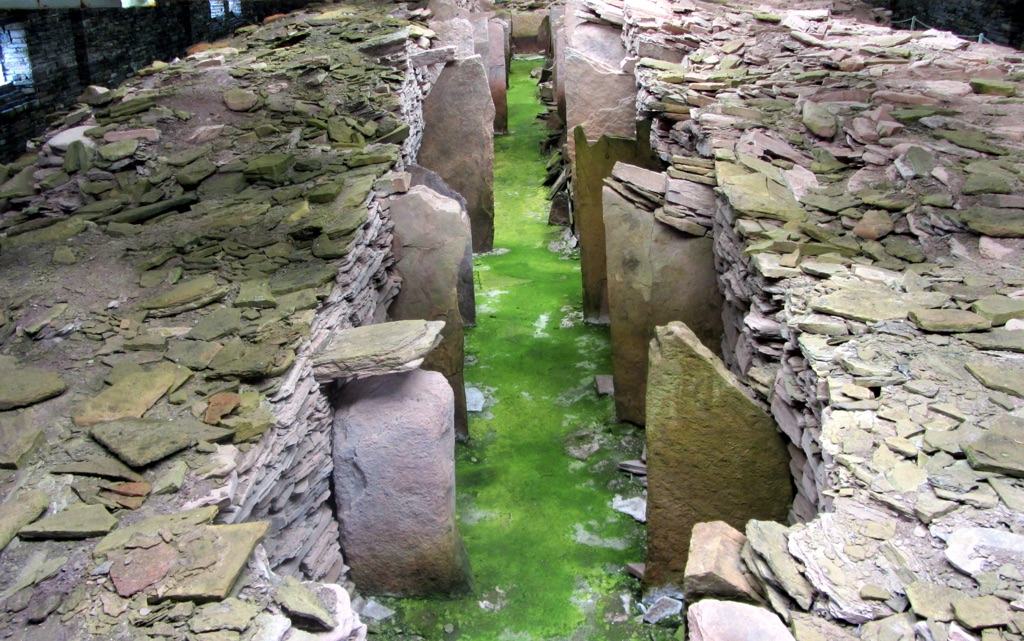The Midhowe Chambered Cairn is a large Neolithic tomb located on the Orkney Islands, Scotland. It’s part of the Rousay island’s “Great Ship of Death,” a nickname that reflects its elongated shape and size. This cairn is one of the most impressive and well-preserved tombs from the Neolithic period in northern Europe. It provides valuable insights into the burial practices and spiritual beliefs of the communities that thrived in Orkney over 5,000 years ago.
Get your dose of History via Email
Historical Background of Midhowe Chambered Cairn
Discovered in the 1930s, the Midhowe Chambered Cairn has since been a focal point of archaeological interest. Walter Grant unearthed it, and subsequent excavations have revealed much about its construction and use. The cairn dates back to the Neolithic period, built by the ancient people of Orkney. These communities left behind a rich legacy of stone-built structures, including the famous Skara Brae.
While the builders’ identities remain a mystery, they were clearly skilled in stonework and had complex social and spiritual practices. The cairn’s design suggests it was a communal burial site, serving multiple generations. Over time, the site fell into disuse and was eventually forgotten until its rediscovery in the 20th century. It has not been the scene of any known historical events since its original use, but it stands as a testament to the ingenuity and beliefs of its creators.
There is no evidence that the cairn was inhabited after its initial use as a tomb. However, its preservation allows us to glimpse into the past. The structure has withstood the test of time, largely due to the quality of its construction and the Orkney climate, which has helped to protect it from the elements.
The Midhowe Chambered Cairn is not just an isolated monument. It is part of a wider landscape of Neolithic sites on the Orkney Islands, which together tell the story of a sophisticated and interconnected prehistoric society. These sites collectively contribute to our understanding of Neolithic life in this remote part of the world.
The cairn’s discovery and subsequent studies have provided invaluable information about Neolithic Orkney. It has become an essential part of the narrative of prehistoric Britain, offering insights into the lives and deaths of its ancient inhabitants.
About Midhowe Chambered Cairn
Midhowe Chambered Cairn is a testament to Neolithic engineering. It is a large, rectangular tomb enclosed by a stone wall and covered by a large mound of earth and stones. The cairn measures about 30 meters in length, and its interior is divided into a series of chambers by large slabs of stone.
The structure’s walls are built from carefully placed stones, showcasing the builders’ skill. The cairn’s roof, now gone, was likely made of flat stones supported by the larger upright slabs. This design created a series of compartments within the cairn, where the remains of the dead were placed.
Archaeologists have noted the use of local materials in the cairn’s construction. The stones used were sourced from nearby areas, demonstrating the builders’ knowledge of their environment and their ability to manipulate it to suit their needs.
The architectural highlights of Midhowe Chambered Cairn include its impressive size and the precision with which the stones were arranged. The cairn’s layout is complex, with a long central passageway leading to the various chambers, suggesting a ritualistic approach to burial.
The craftsmanship of Midhowe Chambered Cairn indicates a society that placed significant emphasis on the treatment of the dead. It also reflects the community’s social structure and the resources they could mobilize for such an enduring construction project.
Theories and Interpretations
Several theories exist about the use and significance of Midhowe Chambered Cairn. Most agree that it served as a communal burial site, where the remains of the dead were interred with ceremony and care.
Some interpretations suggest that the cairn played a role in ancestor worship or the belief in a connection between the living and the dead. The elaborate structure of the cairn could indicate that it was a place of ritual and remembrance, not just a tomb.
The mysteries of Midhowe Chambered Cairn include the exact beliefs and rituals of its builders. Without written records, archaeologists must rely on the physical evidence and comparisons with other Neolithic sites to piece together the cairn’s story.
Historical records from later periods, such as the Viking Age, provide no direct information about the cairn. However, they do offer context for the broader history of the Orkney Islands, which can indirectly inform our understanding of the Neolithic period.
Dating of the cairn has been carried out using radiocarbon methods, confirming its construction in the Neolithic period. This dating helps to align the cairn with other contemporary sites and supports theories about the widespread nature of such burial practices in prehistoric Britain.
At a glance
Country; Scotland
Civilization; Neolithic Orkney
Age; Over 5,000 years old (circa 3000 BC)
Conclusion and Sources
Reputable sources used in the creation of this article;
- Wikipedia – https://en.wikipedia.org/wiki/Midhowe_Chambered_Cairn
- Historic Environment Scotland – https://www.historicenvironment.scot/visit-a-place/places/midhowe-chambered-cairn/

